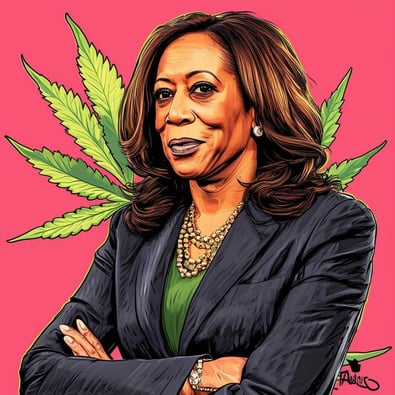Consumable hemp is forcing another rethinking of what constitutes legal cannabis in America.
One of the biggest cannabis tales defining 2024 isn’t about marijuana.
It’s about hemp laws – or more specifically, increasingly popular derivative compounds, such as concentrated delta-9 hemp products and smokeable THCA. The rise in what is now being labeled as “intoxicating” goods has blurred the lines between hemp and marijuana, and is reshaping both industries.
Corporate weed has taken notice. There are now an array of well-known brands jumping in on the action, from Curaleaf to Cookes; (Mike) Tyson 2.0 to Jeeter. The legal anomaly has opened a floodgate of possibilities for companies.
“We are actively having meetings with large distributors of hemp-derived cannabis and we are considering DTC or direct to consumer products shipped from our farm in Southern California directly to people in the states which legally allow it,” California-based Glass House Brands’ CEO Kyle Kazan told investors last month.
“While we are very excited about the prospects as growing this plant is right our wheelhouse and the market is anxious for California grown biomass, return on investment drives our ultimate decision,” Kazan added.
THCA run
The key lies in the 2018 federal Farm Bill’s definition of hemp: cannabis plants containing no more than 0.3% delta-9 THC by dry weight. But that bill didn’t explicitly regulate THCA, the non-psychoactive precursor to THC that occurs naturally in the plant. When heated, THCA converts to THC, producing the “high” associated with marijuana use.
The distinction has also in turn created a thriving market for THCA products in states where traditional marijuana either exists a little bit or not at all from a legal perspective.
Still, the regulatory scene has been almost constantly shifting since the Farm Bill was signed into law six years ago, with state and federal agencies often at odds over how to handle the new dilemma. In California, Gov. Gavin Newsom recently issued emergency rules aimed at cracking down on “intoxicating” hemp products, and similar moves have been made recently by officials in New Jersey and Missouri.
“The bummer parts of (those rules), it doesn’t affect us,” Graham Farrar, co-founder and president of Glass House, told Green Market Report this week. “If anything, it’s probably better for our business because it’s going to funnel a bunch of new consumers who found out about this back into dispensary channel.”
However, Farrar recently told investors that the three populous states of Florida, New York and Texas “currently have laws standards that would allow this flower and edibles to be shipped into them. So, the market size is potentially massive. And frankly, it looks more like we would’ve expected and hoped cannabis to look at this point.”
“We are one of the best California growers,” Farrar said to Green Market Report. “Whatever regulatory program we need to work towards to get it to those consumers, we will do it.”
At the federal level, the situation is equally complex. The Drug Enforcement Administration has stated that it considers THCA to be a controlled substance.
But a recent federal appeals court ruling challenged that interpretation, stating that once something is defined as hemp under the federal definition, it remains hemp regardless of subsequent processing.
‘Big picture’
Some industry experts say a disconnect behind lawmakers’ lack of understanding on hemp’s more industrial uses is historically rooted in the Gilded Age’s tycoons working against hemp development altogether, despite the plant being a practical commodity everywhere else in the world to this day.
“There was a lot of industries that hemp touched that were suddenly, once the kind of the millionaire-billionaire guys – the Rockefellers and William Randolph Hearst and others … once they got involved, then they promoted policies that was in their best interest,” said Beau Whitney, an economist who specializes in the cannabis industry.
But it’s more than just ideological gridlock among business owners across both aisles of the more-recent hemp vs. marijuana beef. The regulatory and legal rifts are creating a climate of uncertainty that’s hurting hemp just as much as marijuana.
“Investors are like, ‘Well, to hell with this, I’m not going to deal with this. I don’t know what’s going to be legal one day and what’s illegal another,'” Whitney explained.
With hemp, that doubt affects everything from fiber production to grain cultivation to animal feed, which Whitney said farmers are “screaming for” due to a worldwide shortage.
“American animal farmers are culling their herds because they can’t feed them, and then people are wondering why prices are going up for meat, but a lot of that could be solved,” he said.
Whitney’s own analysis suggests a potential $28 billion market for federally-legal hemp products. But realizing such potential for now requires navigating a complex web of regulations that can vary dramatically from state to state.
The surging growth of the intoxicating hemp market has also raised concerns about product safety and age restrictions. Unlike regulated cannabis products, many hemp-derived products aren’t subject to the same testing and labeling requirements.
“We don’t think products should be untested,” Farrar said. “We think they should be safe to consume.”
Still, “There’s no agreement on the definition for what intoxicating means, right?” he pointed out.
Farrar supports a more unified approach to cannabis regulation, drawing parallels to the alcohol industry.
“You don’t see a lot of bathtub gin, right? There’s not a lot of fake alcohol. Speakeasies are not a thing anymore, because they just treat it rationally,” he said. “And if we do that in cannabis, all these problems are going to solve themselves.”
The art of ‘common sense’
THCA and other hemp-based products could – both literally and proverbially – keep doors open for struggling cannabis businesses and also bypass medical marijuana’s common, now-traditional barriers. Hence the appeal to so many longstanding marijuana companies.
From banking restrictions to the inability to transport products across state lines, those already on their favorite brands’ email lists will continue to see direct-to-consumer advertisements, unless Congress decides to kill the party by the upcoming Sept. 30 Farm Bill deadline.
“But a lot of this policy is done based upon emotion,” Whitney said. “When people kind of take the emotion out of the issue and they start looking at it from, a human perspective or from an employment perspective, then they tend to change their mind a little bit.”
Ill-informed legislation is merely stifling innovation and investment across the entire hemp sector, Whitney said. He argued for more nuanced policy.
“We need to regulate at the product intention level,” Whitney said.
He envisions a system where hemp products are regulated based on their intended use, rather than a one-size-fits-all approach.
“If you’re making something that’s intended to be consumed, not testing for pesticides or byproducts to make sure it’s safe” doesn’t make sense, Whitney argues.
On the flip side, he questions the logic of current regulations that require testing THC levels in non-consumable hemp products like roof tiles or textiles.
“We need some common sense to go into all this, and there needs to be a lot less emotion, a lot less villainization of the hemp industry.”





